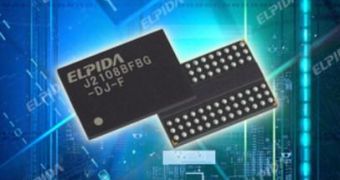It has been known for months that Elpida was going to soon begin the manufacture of its, and supposedly the world's, smallest DDR3 chip yet, and it appears that production has finally started.
Semiconductor manufacturing processes have a habit of moving on to more advanced nodes each year, enabling higher performance, capacities and lower power consumption.
With each new step, those companies that manufacture them also have the habit of discovering or inventing some new way to add extra advantages.
Regardless, there is a competition in this field as there is on any other level of the IT industry, as manufacturers strive to get ahead of the others.
In this instance, Elpida seems to have gained the upper hand, having created what is claimed to be the world's smallest DDR3 chip so far.
With a capacity of 2 Gb, the DRAM is based on the 25nm manufacturing process technology and will mainly be employed in server applications and personal computers (PCs).
For those that want the specifics as to what the 2 Gb chip is capable of, it works on 1.35 V or 1.5 V of power and at a clock speed of 1,866 MHz.
All in all, when compared to a 30nm-based chip of the same capacity, it consumes 15% less operating current and 20% less current when on standby.
Finally, the data width is of x4-bit or x8-bit, while the operating case temperature range (TC) is from 0 to 95 degrees Celsius.
In the near to mid-term, by the end of the ongoing year (2011) to be exact, Elpida should also get around to releasing a 4 Gb DDR3 DRAM chip based on the same process.
Of course, in addition to data centers and PCs, 25nm DRAM should come in useful in such things as notebooks, game consoles, flat screen TVs, various consumer electronics and, as one could probably guess, even tablets.

 14 DAY TRIAL //
14 DAY TRIAL //